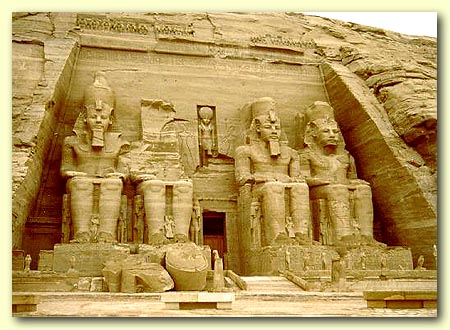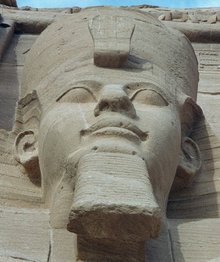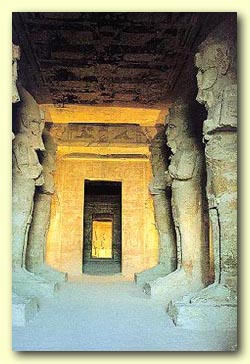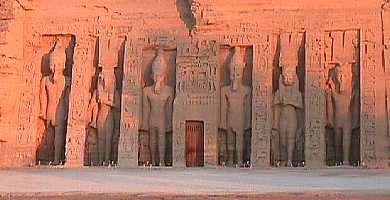Abu
Simbel

In 1257
BCE, Pharaoh Ramses II (1279-13 BCE) had two temples carved out
of solid rock at a site on the west bank of the Nile south of
Aswan in the land of Nubia and known today as Abu Simbel. Long
before Ramses II, the site had been sacred to Hathor of Absek.
The temple built by Ramses, however, was dedicated to the sun
gods Amon-Re and Re-Horakhte. Because of their remote location
near the Sudanese border in sourthern Egypt, the temples were
unknown until their rediscovery in 1813. They were first
explored in 1817 by the Egyptologist Giovanni Battista Belzoni.
 Not
only are the two temples at Abu Simbel among the most
magnificent monuments in the world but their removal and
reconstruction was an historic event in itself. When the temples
(280 km from Aswan) were threatened by submersion in Lake
Nasser, due to the construction of the High Dam, the Egyptian
Government secured the support of UNESCO and launched a world
wide appeal. During the salvage operation which began in 1964
and continued until 1968, the two temples were dismantled and
raised over 60 meters up the sandstone cliff where they had been
built more than 3,000 years before. Here they were reassembled,
in the exact same relationship to each other and the sun, and
covered with an artificial mountain. Most of the joins in the
stone have now been filled by antiquity experts, but inside the
temples it is still possible to see where the blocks were cut.
You can also go inside the man made dome and see an exhibition
of photographs showing the different stages of the massive
removal project.
Not
only are the two temples at Abu Simbel among the most
magnificent monuments in the world but their removal and
reconstruction was an historic event in itself. When the temples
(280 km from Aswan) were threatened by submersion in Lake
Nasser, due to the construction of the High Dam, the Egyptian
Government secured the support of UNESCO and launched a world
wide appeal. During the salvage operation which began in 1964
and continued until 1968, the two temples were dismantled and
raised over 60 meters up the sandstone cliff where they had been
built more than 3,000 years before. Here they were reassembled,
in the exact same relationship to each other and the sun, and
covered with an artificial mountain. Most of the joins in the
stone have now been filled by antiquity experts, but inside the
temples it is still possible to see where the blocks were cut.
You can also go inside the man made dome and see an exhibition
of photographs showing the different stages of the massive
removal project.
In the dictionaries' entry for
egotistic there should be a picture of Ramses II. This was not
his only defect though, he is also one of the most megalomaniac
celebrities of all times.
Officially, he dedicated this temple
to the triad Amon-Ra, Ptah and Ra-Harakhte.
The main purpose to erect this temple was to glorify himself,
though.
The facade of the
main temple is 108 feet high and 125 feet wide with four
colossal seated statues about 65 feet high wearing the double
crown and having the cartouches of Ramesses II. They are taller
than the colossi of Memnon at Thebes and are carved out of solid
rock. At the feet of the calossus, beginning on the left are
Queen Nofretari, Prince Amenhirkhopshef, the Kings mother
Muttuya, Princess Bent'anta, unnamed, but probably Esenofre,
Princess Nebettawy, Queen Muttuya, Princess Nofretari, Princess
Merytamun, Princess Beketmut, Prince Ri'amsese, and Queen
Nofretari, who where all members of Ramesses II's family.
(Editor's Note: We wonder if Ramesses II bribed his kids to make
good grades. Bring home an A and I'll put you in my new
Colossus).

Hathor was the wife of
the Sun God so in a symbolic way, the two Temples, that of
Ramesses II and that of Nefertari, brings Ramesses II and
Nefertari and Hathor and the Sun God together as one. The facade
of the temple is a receding Pylon, just as the larger temple of
Ramesses II. On either side of the entrance to the temple are a
deified statue of Nefertari with statues of Ramesses II on
either side of her. The statues of Nefertari are the same height
as those of Ramesses, which is unusual. Like at Ramesses II's
temple, there are children depicted around their feet. There are
cobras protecting the Temple door.
This temple is much
simpler than the Temple of Re-Herakhte. It has only one
hypostyle hall and the sanctuary. Within the hall are images of
Ramesses in battle with Nefertari present. Other scenes depict
Ramesses being crowned by Horus and Seith and presenting Ma'at
to Amun. On the back wall, Nefertari is before Hathor and Mut.
Just behind the Hypostyle Hall is a small chamber with images of
Hathor cow framed in reeds. Beyond that is the sanctuary with a
divine cow emerging from the rear rock wall protecting Ramesses,
below her. Above the cow, vultures guard the Queens cartouches.
Other scenes show Nefertari offering incense to Mut and Hathor,
and the King worshipping before his own image and that of
Nefertari.
Abu Simbel Tour:-
